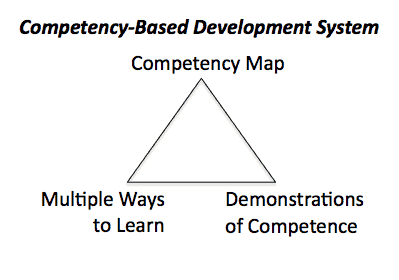Preparing Teachers for Deeper Learning

The Hewlett Foundation believes “All students have the right to a motivating, challenging education that will prepare them to succeed in college, careers, and life and become engaged citizens. The key to that education is deeper learning.”
The Foundation recognizes a common unintended consequence of standards and assessments–a thin test-prep approach stressing regurgitation of facts without development of critical thinking, communication, and collaboration skills. One of the key strategies to making powerful learning experiences available to more students is building teacher capacity. While speaking with a couple of policy experts this week about this challenge, a productive framework for preparing teachers emerged; it includes a talent development framework and a policy framework.
Triangle of Talent Development. Karen Cator, Digital Promise, outlined a powerful triangle for talent development (featured image): a map of what you need to know, different ways to learn it, and ways to show what you know. Those three ingredients are key to any competency-based environment–from K-12 to any form of job training.
For decades, military and corporate trainers have back-mapped learning experiences from job requirements. The introduction of blended environments increasingly has allowed participants more flexible learning pathways in terms of time, place, path and pace. It’s becoming clear that these learning tools and strategies have the potential to create much more productive learning environments for K-12 students. The same competency-based approach with multiple pathways also holds promise for more effective educator preparation compared to the current system characterized by a random array of courses and limited opportunities for practice.
Teacher preparation should follow the triangle of talent development with:
-
A competency map: what teachers need to know and be able to do with some speciality variations (e.g., elementary, blended, online, special needs);
-
Multiple ways to learn: formal and informal; online and blended; individual and cohort learning opportunities; and
-
Demonstration opportunities: performance-based initial licensure based on a system of demonstrated competence (like the Summit Public Schools system with 4 levels of expertise across 7 dimensions of effective teaching and based on multiple observations and data sources).
One benefit of this flexible framework is that unique blended models could create their own competency map and ensure model specific training. Numerous variations of this developmental framework would be available to aspiring teachers and hiring entities with a new policy set.
Policy Framework. Anne Hyslop, New America Foundation, suggested a new state policy frame (similar to the one I outlined last week in a post on Preparing School Leaders) with two key ingredients:
-
Performance-based accreditation. Historically, states have accredited institutions of higher education based on occasional input observations–and there is some consensus that this approach yields a big distribution of mostly ineffective preparation. Accreditation could be shifted to an outcome orientation where providers won the right to license professionals based on the performance of graduate teachers training programs that yielded well prepared teachers would be allowed to expand while those that produce poorly prepared teachers go out of business.
-
Multiple pathways/providers. Based on the success of alternative certification programs, it is clear that there are better alternatives that deserve the right to license professionals. Urban Teacher Center in Baltimore is a good example, they believe schools and districts deserve a guarantee: “Before teachers are certified, they must demonstrate their ability to improve student performance.” HIgh Tech High’s Graduate School of Education and Boston Teacher Residency are two more examples. A variety of pathways would better suit aspiring teachers and could be easily customized to match the needs of schools, districts, and networks.
Cator suggested a third element: a dynamic micro-credentialing system for teachers–a system that would allow them to show what they know and share that efficiently via an online profile. The system of verified expertise could range from content knowledge to demonstrated skills (e.g., high school ELL; special needs and touch technology in a blended setting; college and career advising). Stay tuned as Digital Promise works out the details of micro-credentialing at scale.
A system of teacher development linked to the needs of hiring entities that awarded licenses based on demonstrated competence would provide personalized development pathways for teachers and ensure well-trained teachers for schools.
This post spurred the development of a Hewlett-sponsored paper Preparing Teachers for Deeper Learning (2014) and the leadership sequel, Preparing Leaders for Deeper Learning (2015).







Janet Brown
While I do believe that the programs you have outlined above will definitely improve new teacher performance and increase student achievement, I also believe that the American education system is far too preoccupied with having new teacher’s produce exemplary outcomes within too short of a time frame. In other words, I believe that teachers are not really given sufficient time to develop their craft. Research shows that it takes an average of three years for new teachers to learn their craft. Many new teachers are cycled out of the system by then because of standing state and federal laws.
Furthermore, while there may be bad colleges of educations, I think that many colleges do an outstanding job educating new teachers. The trick is, however, taking their knowledge and transferring it into a real classroom setting. Today there is so much more for new teachers to contend with, especially if they are teaching in poor school districts. Often new teachers have to deal with poor work conditions, few classroom supplies, student apathy for learning, and crazed administrators who are trying desperately to keep their jobs. The real trick for teachers is making positive connections with students, who often are facing incredible odds so that they are excited about learning. Once you can capture students’ hearts, you capture their minds and deeper learning can take place.
Replies
Tom Vander Ark
Thanks Janet, for the reasons you point out I'd like to see rapid pathways for content experts to join well supported teams with ongoing development opportunities as we described in Improving Conditions & Careers: http://www.digitallearningnow.com/wp-content/uploads/2013/05/Conditions-and-Careers-Final-Paper1.pdf
tom Vander Ark
SRI is hosting a small conference on next gen platforms in the Bay Area tomorrow. In preparation, we discussed the profound changes heading toward professional schools, as outlined above and in this post:
http://www.gettingsmart.com/gettingsmart-staging/2013/03/next-generation-professional-training-blending-for-me-for-degree/
nick
Tom, thank you for your article, do you know where there has been any analysis/research on output results based accreditation for educational institutions...? Regards Nick